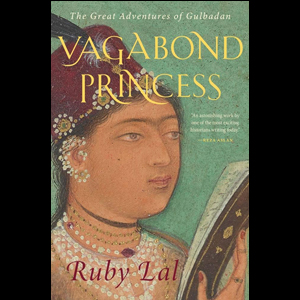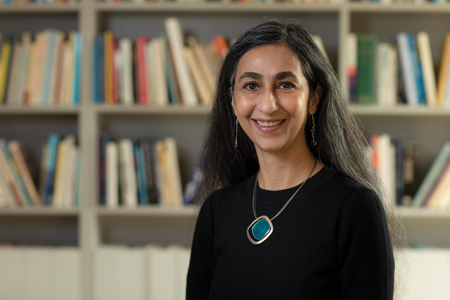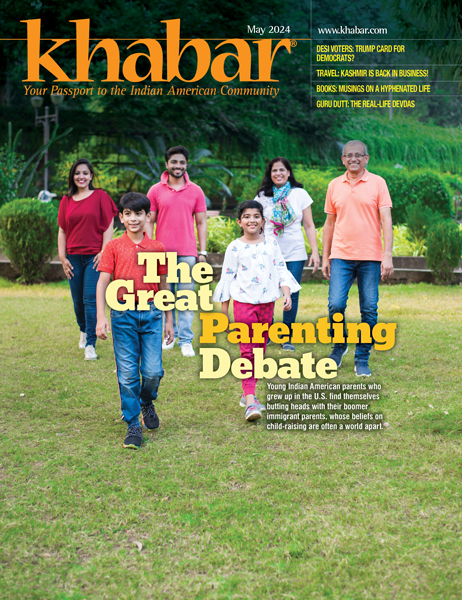Books: The Adventurous Princess

Ruby Lal, professor of South Asian Studies at Emory University, specializes in pre-colonial Indian and feminist history. Vagabond Princess, her latest book, takes readers on an exhilarating journey to the subcontinent and beyond during the early Mughal era. The story is narrated by emperor Babur’s “rose-bodied” daughter, Gulbadan Begum, a spirited wanderer and an astute observer of life in the Mughal court.
The lineage of the great Mughal emperors is forever etched in my memory, thanks to an excellent middle school history textbook for the CBSE curriculum and inspired lectures by Umashankari Miss, my history teacher. We memorized the lineage: Babur, Humayun, Akbar, Jehangir, Shah Jahan, Aurangzeb, ending with Bahadur Shah Zafar. We learned about Birbal (the witty advisor), Abul Fazl (the chronicler), and Fatehpur Sikri (the capital city that grew under Akbar’s regime). There were no women in this remembered lineage—women were parenthetical, mere footnotes. Even in the legends about the Taj Mahal, the monument is presented as Shah Jahan’s symbol of undying love for his consort, with the queen Mumtaz Mahal depicted more as an object of the emperor’s adulation than as a shaper of history.
Vagabond Princess: The Great Adventures of Gulbadan (Yale University Press) is a fascinating historical tale and the first-ever biography of Gulbadan Begum. Born in 1523 in a Kabul fort called Bala Hisar, Gulbadan was the daughter of Babur, the first Mughal emperor. She went on to lead a life that was at once remarkable and ordinary. She was remarkable because we gain an appreciation for the lives of such women—seldom captured in official histories or historiographies—and yet ordinary because Gulbadan was arguably just another example of a Mughal woman who shaped history. She died in 1603.
Lal writes that despite leading more secluded and prescribed lives than men, women were admired in the Mughal court for their mastery of literature, poetry, and prose. The Mughals of the early 1500s lived a semi-nomadic life, with elaborate tents rather than palaces providing shelter. Campsites would move from riverbanks to foothills, engendering a spirit of adventure in young Gulbadan. Having witnessed the ascendancy of Babur, Humayun, and Akbar to the Mughal throne, she chronicled her observations in a work titled Ahval-i Humayun Badshah (Conditions in the Age of Humayun Badshah). Lal’s interpretations draw heavily from Gulbadan’s work, one of the earliest prose texts written by a woman.
By the time Akbar ascended the throne, Gulbadan had established herself as a senior member of the royal family. Akbar granted her and an entourage of royal women a wish to undertake a pilgrimage to Mecca. After a treacherous ship journey that required skillful negotiations with the Portuguese, who controlled the seaports of Gujarat, the Mughal entourage’s goings on in Mecca caused so much mayhem that the Sultan of Turkey, who controlled the holy city, banished them. The remainder of Vagabond Princess is about the entourage’s tumultuous times abroad and eventual return home. Those details are not in Gulbadan’s memoirs, and Lal offers a compelling rationale for why the papers went missing.
While the history is beautifully captured, “A Note on Sources” at the end of the book is also compelling, for it is here that we can truly appreciate the value of Lal’s scholarship. She writes: “[W]ho decides what history is? Who decides what counts as a source? Who decides what is memorable and desirable of the name archive? How does a source become ‘official’ or ‘marginal’? How have the most important Mughal sources been preserved and become available to us? Who writes them, for what purposes, and what happens to their narrative and information in the process of collating, editing, and translating?”
In drawing primarily on an archival source written by a woman, Lal paints a vivid and complex portrait of the life of Gulbadan, one marked by abundance and adventure but also sorrow and intrigue, thus challenging the academic and casual reader alike to rethink how we receive and perceive history.
Girija Sankar, a freelance writer based in the Atlanta metro area, works in global health.
Questions for Professor Ruby Lal
Your interest in Gulbadan’s story has pretty much spanned your career. Are there any aspects of your research into Gulbadan and Mughal history that took you by surprise?
It was my first academic book, Domesticity and Power in the early Mughal World, that brought Gulbadan’s memoir to the attention of the scholarly world. Housed today in the British Library, London, the lone surviving copy of Gulbadan’s memoir cuts off abruptly mid-sentence in folio 83.  Where are the remaining pages? Two decades later and three books on, I continue to wonder what happened to the rest of Gulbadan’s manuscript. What was in the missing pages? During national and international promotional events for Empress, my biography of Mughal co-sovereign Nur Jahan, readers repeatedly asked me about Gulbadan, who appeared in the early pages of the book. She was getting ready to go to Mecca just as baby Nur was making her way to Akbar’s India.
Where are the remaining pages? Two decades later and three books on, I continue to wonder what happened to the rest of Gulbadan’s manuscript. What was in the missing pages? During national and international promotional events for Empress, my biography of Mughal co-sovereign Nur Jahan, readers repeatedly asked me about Gulbadan, who appeared in the early pages of the book. She was getting ready to go to Mecca just as baby Nur was making her way to Akbar’s India.
Photo: Danish Saroee
And so, I found myself gazing simultaneously at two facts: the four years of Gulbadan’s stay in Arabia, and the lost pages of her manuscript, which she’d written at Akbar’s request. I knew Gulbadan was a powerful woman, but in my investigations, I have been amazed at her spirit of adventure and sense of freedom. Amid increasing political tensions, the women were expelled for their “un-Islamic” behavior, a thinly veiled effort to curb Mughal influence in the holy cities, controlled at the time by the Ottoman Sultans of Turkey. Their travels home included a dramatic shipwreck in the Gulf of Aden. Even so, the women didn’t want to return. There was not a word from the Mughals. And so, I set about writing a biography of the Vagabond Princess Gulbadan.
As a feminist historian, if we could call you that, how do you approach teaching history at Emory?
Here is what I share with my students. That at its core, feminist history is embedded in the idea of excavating hitherto expunged experiences, dissociated from our worldview, of non-dominant people such as women, queer people, slaves. A feminist scholar knows in her gut that digging up erased subjects, cardinal in the fabric of history, can turn history upside down. So, we must look where we habitually don’t look, or have been told we can’t look. Books, chronicles, paintings—especially those classified by traditional scholars as “unofficial” and “marginal”—from centuries past are precious gifts. Holding onto their words, we delve into the beauties and torments of human history. That is feminist history. With such rare possessions, we come close to another time. That coming close is feminist history. It is a forceful intellectual and political
praxis that will continue to have power always, because the universe is plural and so are its inhabitants, past and present.
Enjoyed reading Khabar magazine? Subscribe to Khabar and get a full digital copy of this Indian-American community magazine.
blog comments powered by Disqus












